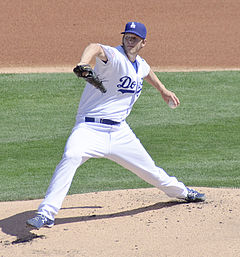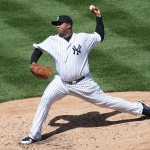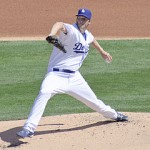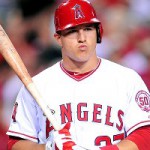Here we are. After a crazy trade deadline in July, and an August and September that featured the division leaders (in most cases) solidifying their positions and extending their leads, the playoffs are upon us.
Lets take a look at the rotations of the playoff teams (despite the fact that the four Wild Card teams are just one-man pitching staffs until they win the play-in game). Who lines up best? For each team i’ve tried to line the pitchers up one through five, with the 5th guy being the one headed to the bullpen.
(Quick useful links: AL full standings on b-r.com, NL full standings, and post season schedule at MLB.com).
Trade deadline 2014 acquisitions highlighted in blue. Pre-season acquisitions highlighted in Green for context.
NL Division Champs:
- Washington: Strasburg, Gonzalez, Zimmerman, Fister, Roark (yes this is how I think it will shake out despite Roark’s great season-long performance; we posted on this separately)
- St. Louis: Wainwright, Lynn, Wacha, Miller, Lackey (Masterson to the bullpen when Wacha came back)
- Los Angeles: Kershaw, Greinke, Ryu, Haren, Hernandez, Wright (Beckett hurt, done for year, Ryu coming back, should be ok for playoffs so I’ve inserted him as the #3. Maholm, Billingsley, Fife hurt all year).
Just look at what the Dodgers have tried to do to keep their rotation afloat in terms of player acquisition over the past couple of years. I’d like to have their budget. They will have no less than eleven capable, MLB-experienced starters once they’re all healthy. Yes Kershaw is unbeatable, but as pointed out earlier this year, they are basically a .500 team otherwise. Their 4th and 5th starters have been below replacement for much of the past month but they’re getting back Ryu right in time for the playoffs. St. Louis’ rotation looks just as strong as it has been for the past few years; Wainwright quietly has 20 wins and a 2.38 ERA on the season. Lynn has been great. Only Miller has struggled but still has a league-average ERA+.
It is hard not to look at the Nationals’ rotation and claim they’re the deepest one-through-four, despite Gonzalez’s struggles. I’d take our #4 (Fister) over anyone else’s #4, I think our #3 matches up just as favorably to anyone els’es #3, and Strasburg has a 1.34 ERA in September as the #1.
NL Wild Card:
- Pittsburgh: Liriano, Cole, Locke, Volquez, Worley (Morton dinged up late Sept, made way for Cole).
- San Francisco: Bumgarner, Hudson, Petit, Vogelsong, Peavy (Lincecum to bullpen for Petit, Cain out all year)
The NL WC pitching match-up will be Bumgarner-Liriano. Both teams manipulated their rotations at season’s end to preserve their aces for the coin-flip game. We’ll do a separate prediction piece.
NL Also-Rans;
- Atlanta: Teheran, Minor, Santana, Harang, Wood (Beachy, Floyd, Medlen out all year)
- Milwaukee: Lohse, Garza, Gallardo, Peralta, Fiers (Nelson and Estrada to bullpen)
The Braves fell so far, so badly in September that they were nearly surpassed by the lowly NY Mets for 2nd place in the NL East. That’s crazy. But they still remain here as an also-ran because they were in the wild card race until mid-September. I still think it is crazy what they were able to accomplish given the starting pitcher injuries they suffered in spring training and don’t quite understand why Frank Wren was fired. If you want to fire him for his crummy FA contracts so be it; but the man engineered a team that made the playoffs three of the past five years. Harsh treatment if you ask me. Insider comments seem to think that Wren lost an internal power-struggle involving Fredi Gonzalez.
And here’s what we’re looking at in the AL:
AL Division Champs:
- Baltimore: Tillman, Norris, Chen, Gonzalez, Gausman (Jimenez demoted to BP)
- Detroit: Scherzer, Verlander, Sanchez, Price, Porcello
- Los Angeles: Weaver, Wilson, Shoemaker, Santiago, Rasmus, LeBlanc (Richards injured, Skaggs hurt)
It is hard to look at these rotations and comprehend where these teams currently stand:
- How is Baltimore leading the AL East by 12 games? None of these guys are a league-wide “Ace.”
- How is Detroit not pulling away from the AL Central with this collection of arms? Of course, you could ask this question of Detroit over and again the past few years; with a stacked lineup and stacked rotation they have just barely won their (usually) weak division year after year.
- How does Los Angeles have the best record in the majors with a non-drafted FA and a waiver claim in their Sept rotation? Would you favor this rotation over Detroit’s?
I guess it doesn’t matter; these teams have bashed their way to their titles and should continue to hit in the post-season. Apparently the O’s aren’t going to go with Gausman in their playoff rotation despite his good seasonal numbers. It may be a case of veteran manager going with the veterans, as Gausman’s numbers are pretty much in line with most of the rest of the Baltimore rotation. The injury to Richards really hurts the Angels: Weaver may be close to an Ace but Wilson showed he is hittable in the post-season and lord knows what will happen when LA has to throw their #3 and #4 choices.
AL Wild Cards:
- Kansas City: Shields, Duffy, Ventura, Guthrie, Vargas
- Oakland: Grey, Samardzija, Lester, Hammel, Kazmir
AL Wild Card looks like a knock-out match-up of Shields and Lester; the A’s burned Grey yesterday to get the win that put them in the playoffs. Oakland has to be kicking themselves; how did they go from (easily) the best team in the majors for the first half to struggling to hang onto the WC spot? On paper replacing 3/5ths of the rotation (out with Chavez, Milone, Pomeranz and Straily, in with Samardzija, Lester and Hammel) sounded like a great idea … but to me the team’s chemistry was clearly un-balanced. At least they held on to the spot and avoiding a one-game play-in against Felix Hernandez.
AL Also-Rans:
- Seattle: Hernandez, Walker, Iwakuma, Paxton, Young (Elias out for year)
- New York: McCarthy, Greene, Kuroda, Capuano, Pineda (with Tanaka finally coming back at season’s end. Nova and Sabathia gone all year with injuries).
All Seattle needed to do was *get* to the wild card game … and they’d have great odds of advancing behind ace Hernandez. But struggled to the finish line. Meanwhile Cleveland and New York would have been mentioned here a week ago, but both squads just ran out of time to make comebacks. I’ll give NY credit: they played 7 games better than their pythagorean record with huge chunks of their rotation gone for the season and depending on guys who’s names I had to look up.
Coming soon; a review of the WC matchups with predictions.





